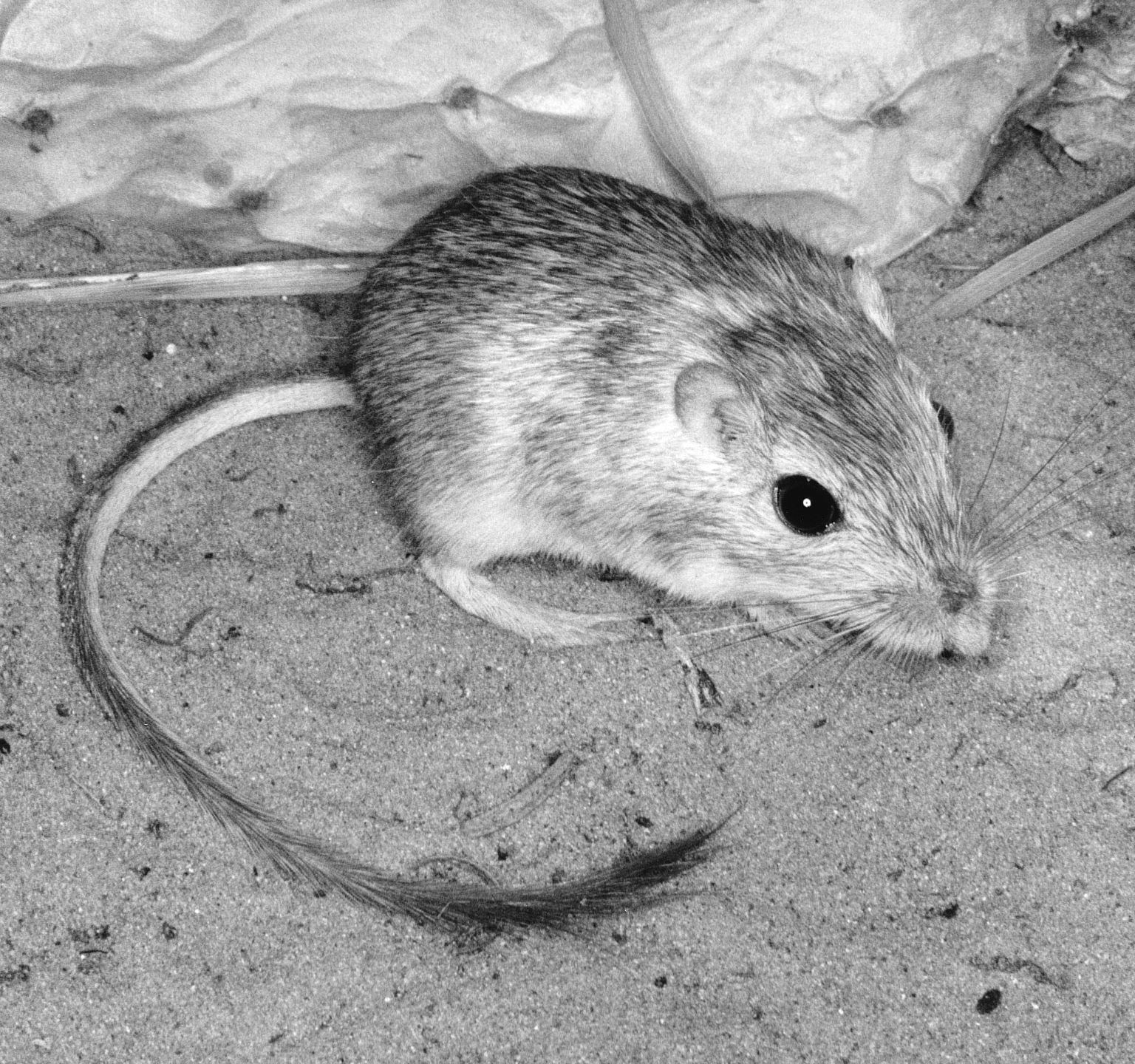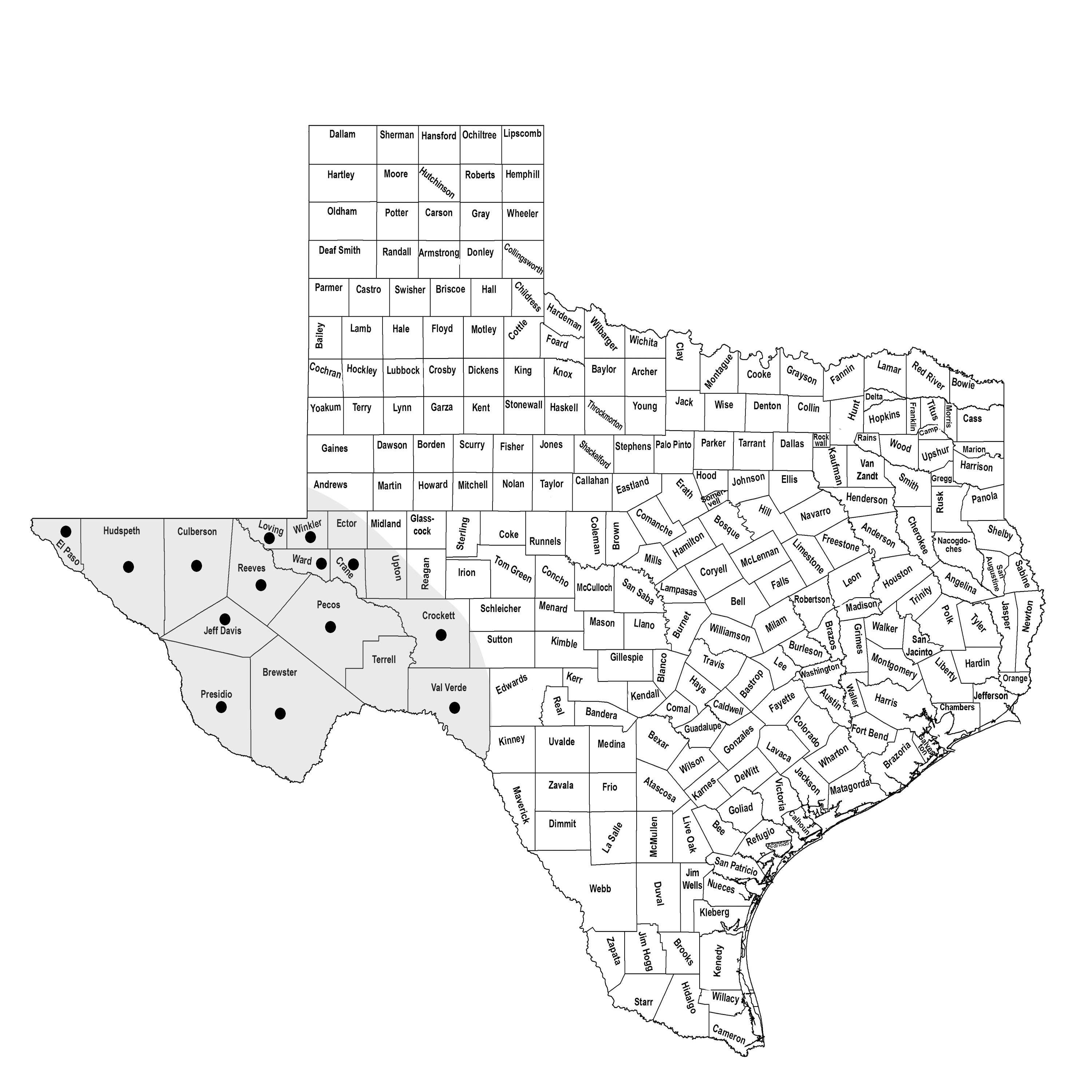CHIHUAHUAN DESERT POCKET MOUSE
Chaetodipus eremicus (Mearns 1898)
Order Rodentia : Family Heteromyidae
DESCRIPTION. A medium-sized pocket mouse with long, heavily crested and tufted tail; pelage coarse but lacking spines on rump; sole of hind foot naked to heel; upperparts vinaceous buff finely sprinkled with black, imparting a grayish tone; sides like back; no lateral line; underparts and tail to tuft white. Dental formula: I 1/1, C 0/0, Pm 1/1, M 3/3 × 2 = 20. Averages for external measurements: total length, 205 mm; tail, 109 mm; hind foot, 25 mm. Weight, 15–23 g.

DISTRIBUTION. A southwestern pocket mouse that, in Texas, occurs in the Trans-Pecos eastward to Val Verde and Crockett counties.

SUBSPECIES. Monotypic species.
HABITS. This species, in general, occurs on sandy or soft alluvial soils along stream bottoms, desert washes, and valleys. In the Big Bend of Texas, large numbers of them have been trapped in loose sand along the Rio Grande where the dominant vegetation was Baccharis and mesquite and also in a brushy draw where the soil was hard-packed silt. Occasionally they may also occupy desert scrubland and desert grassland habitats, but they are seldom found on gravelly soils or among rocks, a habitat preferred by the externally similar Chaetodipus intermedius and C. nelsoni. Their burrows, from which the sand has been thrown well out to one side, are usually found near the bases of bushes and are closed in the daytime.
Their habits are not well known. Like other pocket mice, they are strictly nocturnal. They are known to be less active during the winter months and may enter a period of torpor during extremely cold weather. Their food consists of seeds; those of mesquite, creosote bush, and broomweed have been found in their cheek pouches.
In 1962, Richard Porter found that in the Big Bend area the breeding season of this pocket mouse began in late February, the peak of pregnancies among females was in April, and the peak of juveniles in the population occurred in May. Lesser peaks of pregnancy occurred in June and August. The number of embryos per litter ranged from two to six (average 3.6). Many of the young females reached sexual maturity early and became pregnant while still in their juvenile pelage.
The annual population turnover in this species is high, nearly 95%, according to Porter's studies. Consequently, only 5% of the individuals present at the season's peak survived 12 months in the wild. Only 2 juveniles of the 89 live-trapped animals he handled survived >1 year.
POPULATION STATUS. Common. The Chihuahuan desert pocket mouse is common throughout its range in Texas.
CONSERVATION STATUS. The IUCN lists the Chihuahuan desert pocket mouse as a species of least concern, and it does not appear on the federal or state lists of concerned species. It does not appear to face any serious threats at this time.
REMARKS. In previous editions this species was referred to as Chaetodipus penicillatus. However, studies in the mid-1990s of allozymes, chromosomes, and mitochondrial DNA sequences by Tom Lee (Abilene Christian University) and colleagues have shown that C. penicillatus should be divided into two species (C. penicillatus, a Sonoran Desert form, and C. eremicus, a Chihuahuan desert form). Thus, Texas specimens of this species are now classified as C. eremicus.
Chaetodipus eremicus can be confused with two other species of Chaetodipus, C. nelsoni and C. intermedius, that occur in the Trans-Pecos. All three species have been documented in Big Bend Ranch State Park in southern Presidio County, and in 1997, Frank Yancey (Reedley College) in his study of the mammals of that region documented some useful ways to distinguish them. It is fairly easy to differentiate C. eremicus from C. nelsoni. The former usually is paler in color, lacks rump spines, and has pale-colored soles on the hind feet. Differentiation between C. eremicus and C. intermedius poses more of a problem, as the appearance of the dorsal pelage of these two mice is similar. However, upon close examination, weak rump spines can be noticed on C. intermedius, whereas they are completely absent from C. eremicus. The three species also can be distinguished by professional mammalogists on the basis of subtle differences in cranial morphology.
From The Mammals of Texas, Seventh Edition by David J. Schmidly and Robert D. Bradley, copyright © 1994, 2004, 2016. Courtesy of the University of Texas Press.
Natural Science Research Laboratory
-
Address
Museum of Texas Tech University, 3301 4th street, Lubbock, TX 79409 -
Phone
806.742.2486 -
Email
nsrl.museum@ttu.edu

